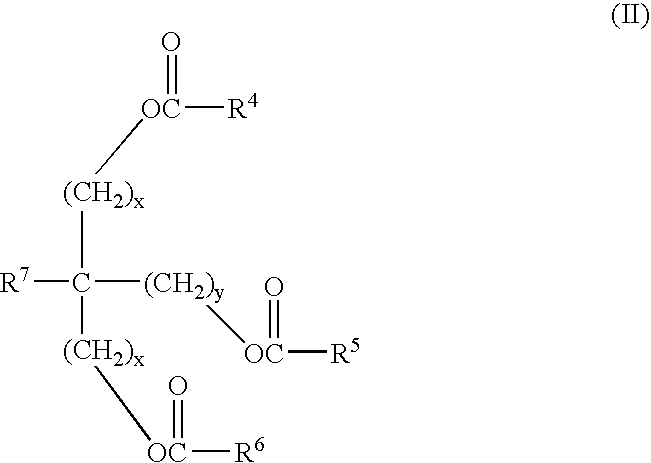Lubricating base oil compositions and methods for improving fuel economy in an internal combustion engine using same
a technology of base oil and composition, which is applied in the direction of lubricant composition, electrical coke oven heating, coke oven details, etc., can solve the problems of engine limited life of engine oil used in internal combustion engines, and oil in the engine, so as to improve the fuel economy of the internal combustion engine, improve stability, and improve the effect of lubricating performan
- Summary
- Abstract
- Description
- Claims
- Application Information
AI Technical Summary
Benefits of technology
Problems solved by technology
Method used
Image
Examples
example 1
[0119] The additive package used in the following examples was formed containing the additives set forth below in Table 1.
TABLE 1COMPONENTSAMOUNT*Borated succinimide dispersant3.2wt. %Ashless dispersant5.2wt. %Low overbased calcium sulfonate0.34wt. %High overbased calcium sulfonate1.55wt. %Dialkylated diphenyl amine1.5wt. %Secondary zinc dialkyldithiophosphate0.66wt. %Ashless dithiocarbamate0.5wt. %Molybdenum / succinimide complex0.75wt. %Silicon-based foam inhibitor5.0PPMViscosity modifier4.10wt. %Pour point depressant0.2wt. %
*Concentrations are based on the total weight of the lubricating oil composition
[0120] Each of the additives in Table 1 are described as follows:
[0121] Borated succinimide dispersant prepared from polyisobutylene, succinic anhydride, and a polyethylene polyamine; and post-treated with boric acid.
[0122] Ashless dispersant—An ashless succinimide dispersant prepared from 2300 molecular weight polyisobutylene, succinic anhydride, and a polyethylene polyamine; a...
example 2
[0132] A lubricating oil composition was formed by adding to a lubricating base oil composition of 90 wt. % of Fischer-Tropsch derived base oil identified herein as CHEVCA4FT and 10 wt. % of Emery 2925 (a triesterified polyol ester derived from C8-C10 acids) available from Cognis Corporation (Ambler, Pa.), the additive package of Example 1. The product lubricating oil composition had a kinematic viscosity of 8.1 cSt at 100° C. and a phosphorous content of approximately 0.05 wt. %.
[0133] CHEVCA4FT Fischer-Tropsch derived base oil can be characterized as set forth in Table 2.
TABLE 2PROPERTIESCHEVCA4FTWax FeedFe-Based FT WaxHydroisomerization Temp, ° F.682Hydroisomerization DewaxingPt / SAPO-11CatalystReactor Pressure, psig1000Viscosity at 100° C., cSt4.524Viscosity Index149Aromatics, wt %0.0109Olefins by Proton NMR, Wt %0.9FIMS Analysis, Weight % Alkanes89.4 1-Unsaturations10.4 2-6-Unsaturations0.2 Total100.0Molecules with Cycloparaffinic9.7Functionality, Weight % byFIMSMolecules wit...
example 3
Thin Film Oxygen Uptake Test
[0137] The Thin Film Oxygen Uptake Test (TFOUT) was conducted according to the standard test method specified in ASTM D 4742.
[0138] The test oil compositions of Example 1 and Comparative Examples A-C were each mixed in a glass container with three other liquids that were used to simulate engine conditions: (1) an oxidized / nitrated fuel component, (2) a mixture of soluble metal naphthenates (lead, copper, iron, manganese, and tin naphthenates), and (3) distilled water.
[0139] The glass container holding the oil mixture was placed in a high pressure reactor equipped with a pressure gage. The high pressure reactor was sealed, charged with oxygen to a pressure of 620 kPa (90 psig), and placed in an oil bath at 160° C. at an angle of 30° from the horizontal. The high pressure reactor was rotated axially at a speed of 100 rpm forming a thin film of oil within the glass container resulting in a relatively large oil-oxygen contact area.
[0140] The pressure of t...
PUM
| Property | Measurement | Unit |
|---|---|---|
| kinematic viscosity | aaaaa | aaaaa |
| temperature | aaaaa | aaaaa |
| kinematic viscosities | aaaaa | aaaaa |
Abstract
Description
Claims
Application Information
 Login to View More
Login to View More - R&D
- Intellectual Property
- Life Sciences
- Materials
- Tech Scout
- Unparalleled Data Quality
- Higher Quality Content
- 60% Fewer Hallucinations
Browse by: Latest US Patents, China's latest patents, Technical Efficacy Thesaurus, Application Domain, Technology Topic, Popular Technical Reports.
© 2025 PatSnap. All rights reserved.Legal|Privacy policy|Modern Slavery Act Transparency Statement|Sitemap|About US| Contact US: help@patsnap.com


